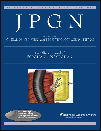Fecal Calprotectin: A Quantitative Marker of Colonic Inflammation in Children With Inflammatory Bowel Disease
Supported in part by grants from the County Council of Västmanland, the Mayflower Charity Foundation for Children, Bengt Ihre's Foundation, and Sällskapet Barnavård, Sweden.
ABSTRACT
Objectives:
The protein calprotectin (S100 A8/A9) is present in neutrophils, monocytes, and macrophages. Colorectal inflammation can be detected by increased excretion of fecal calprotectin (FC). The aim of this study was to evaluate FC as a quantitative marker of inflammatory activity in children with inflammatory bowel disease (IBD).
Patients and Methods:
Thirty-nine children with IBD delivered a fecal spot sample and underwent colonoscopy. The samples were examined with an enzyme-linked immunosorbent assay for FC (Calprest, Eurospital, Trieste, Italy). The concentrations were correlated to macroscopic and microscopic assessments of extent and severity of inflammation in 8 colonic segments for each patient.
Results:
FC correlated significantly to the macroscopic extent (Spearman ρ = 0.61) and the severity (Spearman ρ = 0.52) of colonic inflammation and to a macroscopic, combined extent and severity score (Spearman ρ = 0.65). Significant correlations also were found to the microscopic extent (Spearman ρ = 0.71) and severity (Spearman ρ = 0.72) of colonic inflammation and to a microscopic, combined extent and severity score (Spearman ρ = 0.75). The median FC was 392 μg/g (95% confidence interval [CI], 278–440) in children with clinical IBD symptoms (n = 23) and 32.9 μg/g (95% CI, 9.4–237) in asymptomatic IBD patients (n = 16). Of the asymptomatic children, 56% had a complete microscopic mucosal healing, and their median FC was 9.9 μg/g (95% CI, 5.9–41.9).
Conclusions:
FC can be used as a surrogate marker for estimation of colonic inflammation in pediatric IBD. Normalized FC concentration seems to indicate complete mucosal healing. FC is simple to obtain and analyze; this should facilitate objective assessment and monitoring of IBD activity.




